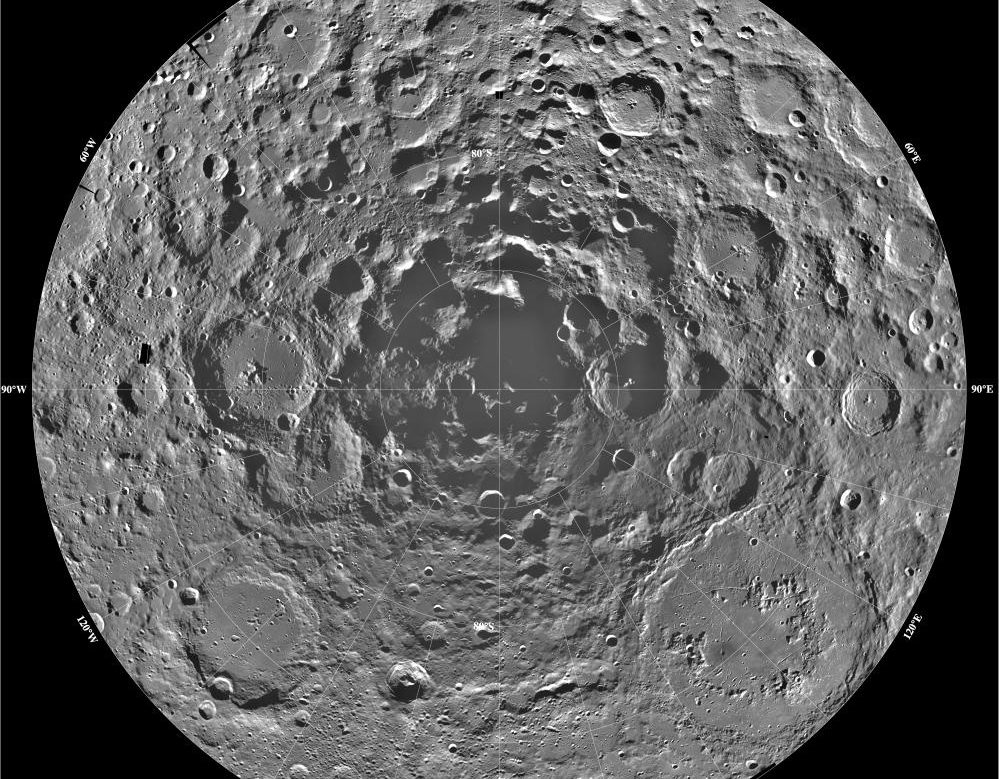Water and Hydrogen Abundance on Lunar Poles Whet Corporate Appetites…
There’s nothing like being farsighted. And by seeing far, we are talking of opportunities 400.000 kilometers away!.. Some companies in the U.S. are already reported to be mapping strategies to corner the fuel market in space. The site of the projected fuel station is the Moon. To be more specific, its south pole (shown in the mosaic photograph above) where water ice and hydrogen were found to be relatively in greater supply. And for NASA scientists, ice means fuel. Cars running on water may still be a distant dream on Earth; but fuel s propelling powerful rockets into space are hydrogen and oxygen, that is, components of ordinary water.
Available data point to the presence of one billion tons of water ice preserved in permanently shaded crater slopes facing the south pole, with another 600 million tons estimated for the north pole.
Although Timothy McClanahan of NASA’s Goddard Space Flight Center points out that “the Moon is drier than the driest desert on Earth” despite its estimated water budget, the volume could be revised upward when surveillance equipment with better resolution brings into focus slopes of smaller craters . McClanahan also cautions that current data do not permit reliable predictions concerning the economic utilisation of lunar hydrogen.
How come, then, commercial enterprises have set their sights on the water sheltering in dark slopes of frigid craters? The reason is that despite the distance and the challenges likely to be encountered, extracting water from the Moon will be still lot cheaper than lofting it to space from the Earth. Experts calculate the cost of carrying just a bottle of water to space in terms of thousands of dollars.
The Texas-based Shackleton Energy Company (SEC) plans to split lunar ice into its hydrogen and oxygen components and sell them as liquid rocket fuel to customers interested in sending space craft to the low Earth orbit.
The company CEO Dale Tietz is sounds confident that the cost of fuel from the gas station on the Moon will be much less than the propellant carried from the Earth. With part of the water products to be extracted by the robotic equipment and humans to be housed at lunar poles, the company plans to supply power to mining equipment, transport vehicles and habitats of the would-be Moon miners.
The Moon Express, another company with lunar ambitions, envisions using lunar ice to produce high-performance hydrogen peroxide fuel (High Test Peroxide) both to sell it to spacecraft operators and to power its own mining operations on the Moon. Hydrogen peroxide is a molecule made of two hydrogen and two oxygen atoms, which is rendered highly reactive with catalyzers. HTP is peroxide fuel purified up to 90 percent.
Moon Express is aiming to put its MX-1 lander it unveiled in December 2013 to lunar surface by the end of 2015 to grab the 30-million-dollar Google XPRIZE.
The lunar plans of China, which successfully landed a rover named “Jade Rabbit” on the Moon in December 2013, are even more ambitious. Aiming to set up a base on the Moon, China hopes to mine the lunar surface for such “rare earth elements” critical for electronics industry as lanthanum, neodymium, lithium, niobium, yttrium, dysprosium whose supplies are dwindling at home.
Another bonus China seeks from its Moon program is mining helium-3, an isotope with possible use in fusion reactors of the future. Produced at the Sun’s core and blown to space in the solar wind, helium-3 cannot make it to the Earth’s surface, unable to penetrate the magnetic shield of our planet. It is, thought to abound, however, on the Moon which does not possess such a shield.
Sources of the fuel
NASA’s Lunar Reconnaissance Orbiter (LRO) and Chandrayaan-1 spacecraft which India had sent to Moon in 2008 to orbit it and map its mineral resources for 10 months, had determined the lunar surface to be surprisingly rich in hydrogen and water.
According to NASA, the water is locked in ice hugging the pole-facing slopes of craters permanently in shade at the South Pole and high latitudes. What’s more, hydrogen and hydroxyl were found to be plentiful also at the North Pole. Sources of the water and hydroxyl in the powdery and abrasive soil called regolith is thought to be asteroids and some comets which smashed onto the Moon in the past, as well as the sun itself.
Migration of the orbits of gas giant planets in the cold outer reaches of the early solar system had let loose a barrage of asteroids and comets on the rocky inner planets and the Moon.
Along with the water transported by these impactors, another major source for lunar water and hydrogen is the solar wind, which is a steady stream of charged particles the sun spews from its surface. Since the Moon lacks a shield of magnetic field like that of the Earth to deflect them, these particles, mostly positively charged hydrogen ions (protons), react with oxygen trapped in Moon rocks, first to produce hydroxyl (composed of a hydrogen and oxygen) and then water (made up of two hydrogen atoms and an oxygen) when hydroxyl captures another hydrogen from the flux. These molecules, energized by solar radiation, hop across the lunar surface and accumulate at cold spots in the shade before sunlight breaks them apart.
REFERENCES
- 1. “One step from Earth”, Physics World, 5 February 2015
- 2. “Mining the moon becomes a serious prospect”, Institute of Physics, 2 February 2015
- 3. “NASA’s LRO Discovers Hydrogen More Abundant on Moon’s Pole-Facing Slopes”, 4 February 2015


